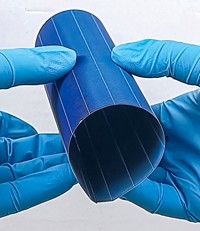Advertisement
Grab your lab coat. Let's get started
Welcome!
Welcome!
Create an account below to get 6 C&EN articles per month, receive newsletters and more - all free.
It seems this is your first time logging in online. Please enter the following information to continue.
As an ACS member you automatically get access to this site. All we need is few more details to create your reading experience.
Not you? Sign in with a different account.
Not you? Sign in with a different account.
ERROR 1
ERROR 1
ERROR 2
ERROR 2
ERROR 2
ERROR 2
ERROR 2
Password and Confirm password must match.
If you have an ACS member number, please enter it here so we can link this account to your membership. (optional)
ERROR 2
ACS values your privacy. By submitting your information, you are gaining access to C&EN and subscribing to our weekly newsletter. We use the information you provide to make your reading experience better, and we will never sell your data to third party members.
Solar Power
Perovskite solar cells score highly on life-cycle analysis
Tandem cells with metallo-organic layers outperform benchmark commercial silicon devices in terms of carbon footprint and environmental impact
by Mitch Jacoby
July 30, 2020
| A version of this story appeared in
Volume 98, Issue 30
Perovskite-based tandem solar cells outperform state-of-the-art commercial silicon cells, according to a life-cycle analysis that evaluates the cells’ energy consumption and production, carbon footprint, and environmental impact (Sci. Adv. 2020, DOI: 10.1126/sciadv.abb0055).
Energy payback time for solar cells
0.35
years for perovskite-perovskite tandem cells
1.52
years for state-of-the-art commercial silicon cells
An effective way to boost the efficiency of solar cells is to combine two types of materials with complementary light-absorbing properties in a tandem cell. Low-cost semiconducting perovskite materials such as methylammonium lead trihalides and formamidinium analogs have been widely studied on their own and in tandem-cell applications. Most investigations have focused on the cells’ power-generating efficiency and long-term stability. Few studies, however, have analyzed the amount of energy needed to manufacture the devices and their impact on the environment.
So Xueyu Tian and Fengqi You of Cornell University and Samuel D. Stranks of the University of Cambridge conducted cradle-to-grave analyses, starting with the energy needed to process and purify raw materials, for two styles of tandem cells: ones with a perovskite layer and a silicon layer and ones with two types of perovskites.
Among other findings, the team determined that it takes the silicon-free cells 0.35 years to generate as much energy as is needed to make them, compared with 1.44 years for perovskite-silicon cells and 1.52 years for benchmark silicon cells. The all-perovskite cells also look promising in terms of overall greenhouse gas emissions, which depend strongly on manufacturing methods and processing. Expressed as grams of CO2-equivalent per kilowatt-hour generated, the value for the silicon-free cells is 10.7 compared with 24.6 for silicon cells.





Join the conversation
Contact the reporter
Submit a Letter to the Editor for publication
Engage with us on Twitter